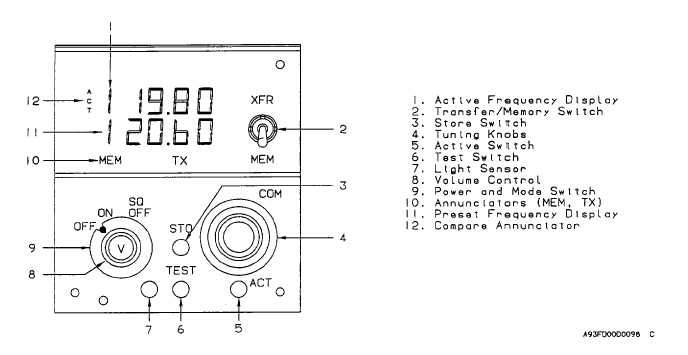TM 1-1510-223-10
Figure 3-4. VHF Communications Transceiver Control Unit
the channel numbers without changing the preset
display. Push the STO switch a second time to commit
the preset frequency to memory in the selected location.
After approximately 5 seconds, the control will return to
normal operation.
(4)
Tuning knobs. Two concentric tuning knobs
control the preset or active frequency displays. The
larger knob changes the three digits to the left of the
decimal point in 1-MHz steps. The smaller knob
changes the two digits to the right of the decimal point in
50-IkH steps (or in 25-kHz steps for the first two steps
after the direction of rotation has been reversed). The
numbers will roll over at the upper and lower frequency
limits.
(5)
Active switch. The active switch, placarded
ACT, enables the tuning knobs to directly tune the VHF
transceiver, when depressed and held for two seconds.
The bottom window will display dashes and the upper
window will continue to display the active frequency.
Pushing the ACT switch a second time will return the
control unit to the normal two-display mode.
(6)
Test switch. This switch placarded TEST
initiates the transceiver self-test diagnostic routine.
(Self-test is active only when the TEST switch is
pressed.)
(7)
Light sensor. This built-in light sensor
automatically controls display brightness.
(8)
Volume control. The volume control is con-
centric with the power and mode switch
(9)
Power and mode switch. The power and
mode switch contains three detented positions. The ON
and OFF positions switch system power. The SQ OFF
position disables the receiver squelch circuits.
(10)
Annunciators. The transceiver control unit
contains a MEM (memory) and a TX (transmit)
annunciator.
The
MEM
annunciator
illuminates
whenever a preset frequency is being displayed in the
lower window. The TX annunciator illuminates whenever
the transceiver is transmitting.
(11)
Preset frequency display. Displays the pre-
set (inactive) frequency and diagnostic messages.
(12)
Compare annunciator. An annunciator
placarded
ACT
momentarily
illuminates
when
frequencies are being changed. The ACT annunciator
flashes if the actual radio frequency to which the
transceiver is tuned is not identical to the frequency
shown in the active frequency display.
c.
Operating Procedures. The frequencies displayed
on the transceiver control unit show only five of the six
digits. The sixth digit is always a zero (when the fifth
digit
3-8

